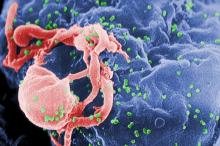Two clinical trials have shown for the first time that daily oral antiretroviral drug prophylaxis can reduce the risk of HIV infection in heterosexual men and women by more than 60%.
The results are likely to fundamentally alter HIV prevention strategies, particularly in Africa where the trials were conducted.
Among 4,758 HIV serodiscordant couples in Kenya and Uganda participating in the Partners Pre-exposure Prophylaxis (PrEP) study, the risk of HIV infection was reduced 62% with tenofovir disoproxil fumarate (Viread) (P value .0003) and 73% with tenofovir in combination with emtricitabine (Truvada) (P less than .0001) compared with placebo. The difference between the two active treatment arms was not statistically significant.
Among 1,200 HIV-negative men and women, aged 18-39 years, in Botswana participating in the Centers for Disease Control TDF2 trial, the overall risk of HIV infection was significantly reduced 63% among participants taking daily tenofovir and emtricitabine versus those taking placebo.
Protection was even greater, with a significant risk reduction of 78%, in a separate analysis among patients known to have a supply of study drugs. That analysis excluded any HIV infections that occurred more than 30 days after a patient reported their last drug dose.
"This news is a major milestone," Dr. Kevin Fenton, director of the CDC’s National Center for HIV/AIDS, viral hepatitis, STD, and TB prevention, said during a telebriefing where the preliminary data were presented. "Heterosexuals are hardest hit by HIV worldwide and these studies give us the first strong compelling evidence that PrEP can work in this population."
Last fall, the iPrEX study reported that pre-exposure prophylaxis reduced HIV transmission in men who have sex with men. However, earlier this year the FEM-PrEP trial demonstrated no protective effect of PrEP among heterosexual women.
Dr. Jonathan Mermin, director of HIV/AIDS Prevention at the CDC, said further efforts are needed both from a scientific and practical standpoint to clarify whether FEM-PrEP failed because of poor drug adherence, specific characteristics in women or other factors. He described the results of the two current trials as a breakthrough in prevention because they provide an additional mechanism to tackle an epidemic that is growing in the world and the United States. Roughly 34 million people are living with AIDS worldwide, with 1.2 million Americans living with HIV, of which 21% are unaware of their infection.
"Up to this point, we have not had the opportunity of taking a drug that would prevent acquisition of HIV among uninfected people, so combined with some of the other newer interventions, it adds to the tool kit," he said.
Dr. Jared Baeten, principal investigator of the Partners PrEP study and University of Washington, Seattle, professor of global health and medicine, remarked that just a few years ago the HIV tool kit was insufficient to reverse the HIV epidemic. "This is really a game changer and now what we need is to get these strategies out to populations at greatest risk," he said.
Questions still remain as to how PrEP will be used in the real world. The CDC is expected to release guidelines in the next few months on the use of PrEP among heterosexual men and women, but urges health care providers to wait for that guidance before implementing PrEP.
However, if providers have patients for whom they believe the initiation of PrEP is urgent, the CDC recommends following the cautions and procedures previously published for PrEP use in men who have sex with men (MSM).
Based on the Partners PrEP finding that tenofovir alone was as effective as tenofovir plus emtricitabine in preventing heterosexual transmission, providers may consider daily doses of either regimen in this population. For MSM patients, however, the interim guidance remains that only combination tenofovir/emtricitabine should be prescribed.
Dr. Michael Thigpen, principal investigator of the TDF2 study and also with the CDC, reiterated that it is a great day for HIV prevention, and pointed out that even after the initial male circumcision studies showed efficacy of more than 50%, there were still no effective means to prevent HIV in women, who comprise the largest proportion of infections in Africa annually. Topical vaginal gels are now available and a test-and-treat strategy for discordant couples was published earlier this year.
"The playing field for HIV prevention has really changed dramatically over the last three or four years, and therefore we are extremely excited about all these different potential tools that are part of our new tool kit," Dr. Thigpen said.

